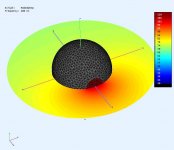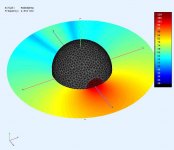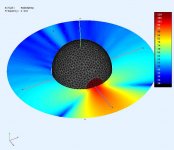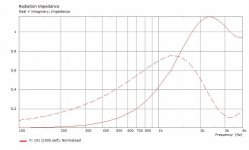This is how I think about 4pi vs 2pi (baffle step)
When wavefront reaches the edge of baffle, it starts to bend over and spread wider around in space (remember this is 3-dimensional), then same energy (spl, amplitude) gets spread into larger space and pressure diminishes.
Diffractions secondary wavefront(s) make minor disturbances locally, ie. variations in pressure with different summation at various deviation angles.
When wavefront reaches the edge of baffle, it starts to bend over and spread wider around in space (remember this is 3-dimensional), then same energy (spl, amplitude) gets spread into larger space and pressure diminishes.
Diffractions secondary wavefront(s) make minor disturbances locally, ie. variations in pressure with different summation at various deviation angles.
Some food for the thought experiment. Acoustic radiation impedance.
The sphere is R200mm, driver is R30mm, and is an ideal membrane under constant force (acceleration).
Up next, a map of radiation impedance from the driver around the sphere. Might take a day.
The sphere is R200mm, driver is R30mm, and is an ideal membrane under constant force (acceleration).
Up next, a map of radiation impedance from the driver around the sphere. Might take a day.
Attachments
Last edited:
It is well known that "air" pressure and temperature affect sound propagation! Is this "impedance" you describe, Don? or the 2pi to 4pi shft?
Acoustic radiation impedance = ( pressure / volume velocity ) and it's dependant on the geometry, distance, and frequency.
Last edited:
Isn't the question about the physics of what's happening academic until the wavefront is observed on the molecular level?
You might as well ask why Huygens' wavelets don't go backwards!What makes you so certain, do you find it inconceivable that they (wavelets) exist?
If the physics seems contrived, it's because it is contrived. If you want to 'make believe' there are secondary wavelets, then you also have to believe they are inhomogeneous.
If you do, you get an extremely powerful technique that works well whether it's 'true' or not.
On that latter point, I think we both agree! 😎
They are spherical.You might as well ask why Huygens' wavelets don't go backwards!
Isn't that what a microphone measures? 🙂
Measures pressure, but has no concept of where it came from or where it is going (ie. particle velocity). Assuming its an omnidirectional mic.
In that case, the technique would not work!They (wavelets) are spherical.
If each wavelet radiated equally in all directions then, in addition to propagating a forward wave, the wavelets would also propagate a backward wave which would travel towards the source.
No such wave is observed, thus the pragmatic need to invoke inhomogeneity.
The term "radiation impedance" is overloaded. This is what ABEC uses and it agrees Kolbrek's Horn book.
.
Attachments
As you pointed out, problems like that are raised in the wiki page I linked to earlier.In that case, the technique would not work!
If each wavelet radiated equally in all directions then, in addition to propagating a forward wave, the wavelets would also propagate a backward wave which would travel towards the source.
No such wave is observed, thus the pragmatic need to invoke inhomogeneity.
I don't, sorry I didn't mean to give that impression. I'm saying they haven't been shown not to be real to my knowledge. Like I said, I think it's an academic question until the wavefront is actually observed.
Neither has the photon wave function been shown not to be 'real', but it describes the interference of light🙂
Last edited:
But that's not good enough for Charlie, he wants to know the physics that causes diffraction, I hope he gets an answer but I think we need pictures to know for sure.
- Home
- Loudspeakers
- Multi-Way
- The frequency dependence of infinite baffle-ism





